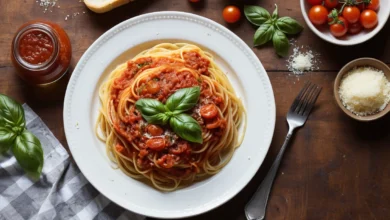The Perfect Gipfeli Recipe: How to Make Flaky, Buttery Swiss Croissants at Home

Gipfeli, the Swiss version of the croissant, is a beloved breakfast pastry known for its flaky, buttery layers and crescent shape. Whether enjoyed with a cup of coffee or as part of a continental breakfast, Gipfeli offers a delightful experience with its crisp exterior and tender, soft interior. While similar to the French croissant, Gipfeli is slightly denser and has a less pronounced buttery flavor, making it unique in its own right. In this comprehensive guide, we’ll walk you through the step-by-step process of making the perfect Gipfeli at home, address frequently asked questions, and provide insights to help you master this iconic Swiss pastry.
What is Gipfeli?
Gipfeli is a crescent-shaped pastry that originated in Switzerland and is often compared to the French croissant. While both pastries share similarities in shape and layering, Gipfeli has a slightly denser texture and is less buttery than its French counterpart. The dough used in Gipfeli typically contains less butter and sugar, which gives it a more subtle flavor. This makes Gipfeli an excellent choice for both sweet and savory fillings.
Ingredients for the Perfect Gipfeli
To make homemade Gipfeli, you’ll need the following ingredients:
- 500g all-purpose flour
- 250ml milk (lukewarm)
- 20g fresh yeast or 10g dry yeast
- 60g unsalted butter (softened)
- 30g sugar
- 1 tsp salt
- 1 egg (for brushing)
- 200g butter (for folding into the dough)
Step-by-Step Guide to Making Gipfeli
Step 1: Prepare the Dough
Start by dissolving the yeast and sugar in the lukewarm milk. Let the mixture sit for about 5 minutes, allowing the yeast to activate. In a separate bowl, combine the flour and salt. Gradually add the milk mixture to the dry ingredients and knead until the dough comes together. Add 60g of softened butter and continue kneading until the dough is smooth and elastic, about 10 minutes. Cover the dough and let it rise for 1-2 hours until it has doubled in size.
Step 2: Prepare the Butter for Folding
While the dough is rising, prepare the butter for folding. Flatten 200g of cold butter into a rectangle between two sheets of parchment paper. This will be folded into the dough to create the flaky layers. Chill the butter in the fridge until it’s firm but still pliable.
Step 3: Roll and Fold the Dough
Once the dough has risen, roll it out into a large rectangle. Place the prepared butter in the center of the dough, folding the dough over the butter like an envelope. Roll the dough out gently and fold it again into thirds. Repeat this rolling and folding process two more times, chilling the dough in the fridge for 20 minutes between each fold.
Step 4: Shape the Gipfeli
After the final fold, roll the dough out into a large rectangle once again. Cut the dough into triangles, making sure each piece is large enough to roll into a crescent shape. Starting from the wider end, roll each triangle toward the tip to create the traditional Gipfeli shape. Place the shaped pastries on a baking tray lined with parchment paper and let them rise for another 30 minutes.
Step 5: Bake the Gipfeli
Preheat your oven to 180°C (350°F). Brush each Gipfeli with a beaten egg for a shiny finish. Bake the pastries for 15-20 minutes, or until golden brown and flaky. Let them cool slightly before serving.
FAQs About Gipfeli Recipe
1. What’s the difference between Gipfeli and croissants?
While both Gipfeli and croissants are crescent-shaped and made with layered dough, Gipfeli has a denser, less buttery texture. Gipfeli dough uses less butter, resulting in a pastry that is slightly more substantial compared to the lighter, airier French croissant.
2. Can I use store-bought puff pastry for Gipfeli?
Yes, if you’re short on time, you can use store-bought puff pastry to make Gipfeli. However, making the dough from scratch allows for better control over the texture and flavor, giving you a more authentic result.
3. What fillings can I add to Gipfeli?
Gipfeli can be enjoyed plain, or you can add sweet or savory fillings. For sweet options, consider chocolate, almond paste, or jam. Savory fillings like ham and cheese also work well, making Gipfeli versatile for different tastes.
4. How do I store Gipfeli?
Gipfeli is best enjoyed fresh, but you can store them in an airtight container at room temperature for up to two days. To reheat, place them in a 150°C (300°F) oven for about 5-7 minutes. You can also freeze Gipfeli before baking; simply thaw and bake as usual.
5. Why is my Gipfeli not flaky?
The key to flaky Gipfeli lies in properly folding and chilling the dough. Make sure to follow the rolling and folding steps carefully, and allow the dough to chill between folds to keep the butter cold. If the butter melts too quickly, the layers won’t form properly, resulting in a less flaky texture.
Key Points and Insights
- Layering is Essential: The process of folding butter into the dough, known as lamination, is what creates the flaky layers in Gipfeli. Be sure to chill the dough between folds to achieve the best results.
- Control the Butter Temperature: The butter should be cold but pliable when you fold it into the dough. If the butter is too hard, it won’t spread evenly between the layers. If it’s too soft, it will leak out, ruining the dough’s structure.
- Versatile Recipe: Gipfeli is a versatile pastry that can be adapted for both sweet and savory fillings. Whether you prefer chocolate or cheese, you can personalize this recipe to suit your tastes.
The History of Gipfeli
Gipfeli has been a staple in Swiss bakeries for centuries. Its origins are closely tied to the development of laminated dough techniques in Europe, which also gave rise to the French croissant. In Switzerland, Gipfeli has become an iconic breakfast item, often enjoyed with coffee or as part of a leisurely Sunday brunch. While the recipe has evolved over time, the core concept of a crescent-shaped, layered pastry remains a beloved tradition in Swiss cuisine.
Nutritional Information
One homemade Gipfeli contains approximately 250-300 calories, depending on the size and ingredients used. It’s a rich pastry that provides a good source of carbohydrates and fats, making it an indulgent treat best enjoyed in moderation. For a lighter version, you can reduce the butter content or opt for a whole-grain flour blend, though this will affect the texture.
Conclusion
Making Gipfeli from scratch may seem intimidating, but the process is straightforward if you follow the steps carefully. With a little patience and practice, you’ll be able to create buttery, flaky Gipfeli that rival those from any Swiss bakery. Whether you’re enjoying them plain or filled with sweet or savory ingredients, Gipfeli is a versatile and delicious pastry that can be enjoyed at any time of day. Try this recipe the next time you want to elevate your breakfast game or impress guests with a homemade treat.





